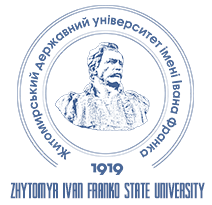THE USE OF SPECIALIZED TUTORING METHODS IN HIGHER INSTITUTIONS FOR THE SECOND BACHELOR’S DEGREE STUDENTS DURING TEACHING-LEARNING THE FOREIGN BUSINESS LANGUAGE BASED ON THE FACULTY OF INTERNATIONAL RELATIONS
DOI:
https://doi.org/10.35433/pedagogy.3(106).2021.71-78Keywords:
teaching methods, foreign business language education, higher education, the second bachelor's degree students, the second bachelor's degree studentsthe second bachelor's degree students, teacher’s qualificationAbstract
In globalized and progressive world more stringent requirements to high institutions are set. Future specialist in international relations not only should be familiarized with professional business competences including a certain number of skills, but due to the principles of the State Educational Standarts in Ukraine they should be able to read foreign scientific and technical literature, find out necessary information and apply the results in a proper way in their professional activity in foreign languages as well. The students’ level of mastering the language directly depends on the teaching methods being used.
It could be observed during all its history the foreign business language teaching methods changed a lot of times emphasizing reading, translating, audition or combining these processes. Each method possesses its own certain importance and answers the specifically set pedagogical tasks e.g. brainstorming, audio-visual aids, group activities etc. The teaching literature review makes it possible to state that nowadays there is no an ideal, universal method yet that would enable to cover all the aspects in such a short time given to the foreign business language teaching-learning in higher institutions. The known combination of the existing methods and the teacher’s qualification, therefore, enables to make the lectures interesting and more effective. Methods: The given research paper is based on the theoratical material of the appliance of various teaching business foreign language methods for the second bachelor's degree students based on the faculty of international relations, as well as on the basis of the results from questioning the second bachelor's degree students who study foreign languages for special purposes in the field of international relations professions, and also of the results from questioning teachers specializing in teaching foreign languages for special purposes. Results: In the students’ opinion, the most effective methods of teaching foreign languages for special purposes in the field of international relations professions are the following: brainstorming method, in-group committee work and audio-visual aids.
References
Bocharova, O.V., & Arefyeva, O.N. (2008). Application of ICT in the classroom and after school. Kurgan: IPKiPRO of Kurgan Region [in English].
Boddewyn, J.J. (2016). International business-government relations research 1945-2015. Concepts, typologies, theories and methodologies. Journal of World Business, 51(1), 10-22 [in English].
DeBernardes, A., & Olsen, E.G. (1948). Audio-visual and community materials – some recent publications. Education Leadership, 256-266 [in English].
Druzhinin, V.I., & Krivolapova, N.A. Organization of innovative activity in educational institution. Kurgan: IPKiPRO of Kurgan region [in English].
Fesenko, O.P., Fedyaeva, E.V., & Bestsennaya, V.V. (2017). Cases in methods of teaching Russian as a foreign language. Lang, 104-117 [in English].
Galskova, N.D. (2003). Modern methods of foreign languages teaching. Moscow: ARKTI [in English].
Kashchuk, S. (2018). The methodology of teaching French language as a foreign in Russia and French-Russian education in cyberspace. Challenges and difficulties needed to skip in secondary school and higher education institute. Xlinguae, 11, 322-335 [in English].
Luyken, G.M., Herbst, T., Langham-Brown, J., Reid, H., & Spinhof, H. (1991). Overcoming Language Barriers in Television: Dubbing and Subtitling for the European Audience. Manchester: European Institute for the Media [in English].
Mathew, N.G., Alidmat, AOH. A study o the usefulness of Audovisual aids in EFL classroom: implications for effective instruction. International Journal of Higher Education, 2, 86-92 [in English].
Mazur, M., Rzepka, R., & Araki, K. (2015). Teaching Words in Context: Code-Switching Method for English and Japanese Vocabulary Acquisition Systems. In Human Language Technology. Challenges for Computer Science and Linguistics. LTC Lecture Notes in Computer Science, Volume 10930. Switzerland [in English].
McCoy, R.I. (1976). Means to Overcome the Anxieties of Second Language Learners. Foreign Language Annals, No. 12, 185-189 [in English].
Nargis, N., & Armelia, L. (2018). Optimizing EFL learners’ communicative competence through short movie project. Asian EFL, 20, 201-208 [in English].
Overcoming language barriers in television: Dubbing and Subtitling for the European Audience. Manchester: European Institute for the Media [in English].
Roslaniec, A. (2018). 5 benefits of using video in class. Retrieved from: https://www.english.com/blog/5-benefits-of-using-video-in-class/ [in English].
Rivers, W.M. (1981). Teaching foreign language skills. University of Chicago Press [in English].
Downloads
Published
Issue
Section
License

This work is licensed under a Creative Commons Attribution-NonCommercial-NoDerivatives 4.0 International License.
Authors published in this journal agree to the following terms:
a) The authors reserve the right to author their work and grant the journal the right to first publish this work under the Creative Commons Attribution License, which allows others to freely distribute the published work with a mandatory link to the authors of the original work and the first publication of the work therein magazine.
b) Authors have the right to enter into separate additional agreements regarding the non-exclusive distribution of the work in the form in which it was published by this journal (for example, posting work in an electronic repository of the institution or publishing as part of a monograph), provided that the reference to the first publication of the work is maintained therein. magazine.
c) Journal policy permits and encourages the submission of manuscripts by the authors on the Internet (for example, in repositories of institutions or on personal websites), both prior to submitting this manuscript to the editorial board and as it contributes to the emergence of productive scientific discussion, and has a positive impact on the promptness and dynamics of citing a published work (see The Effect of Open Access).

 ISSN
ISSN 





